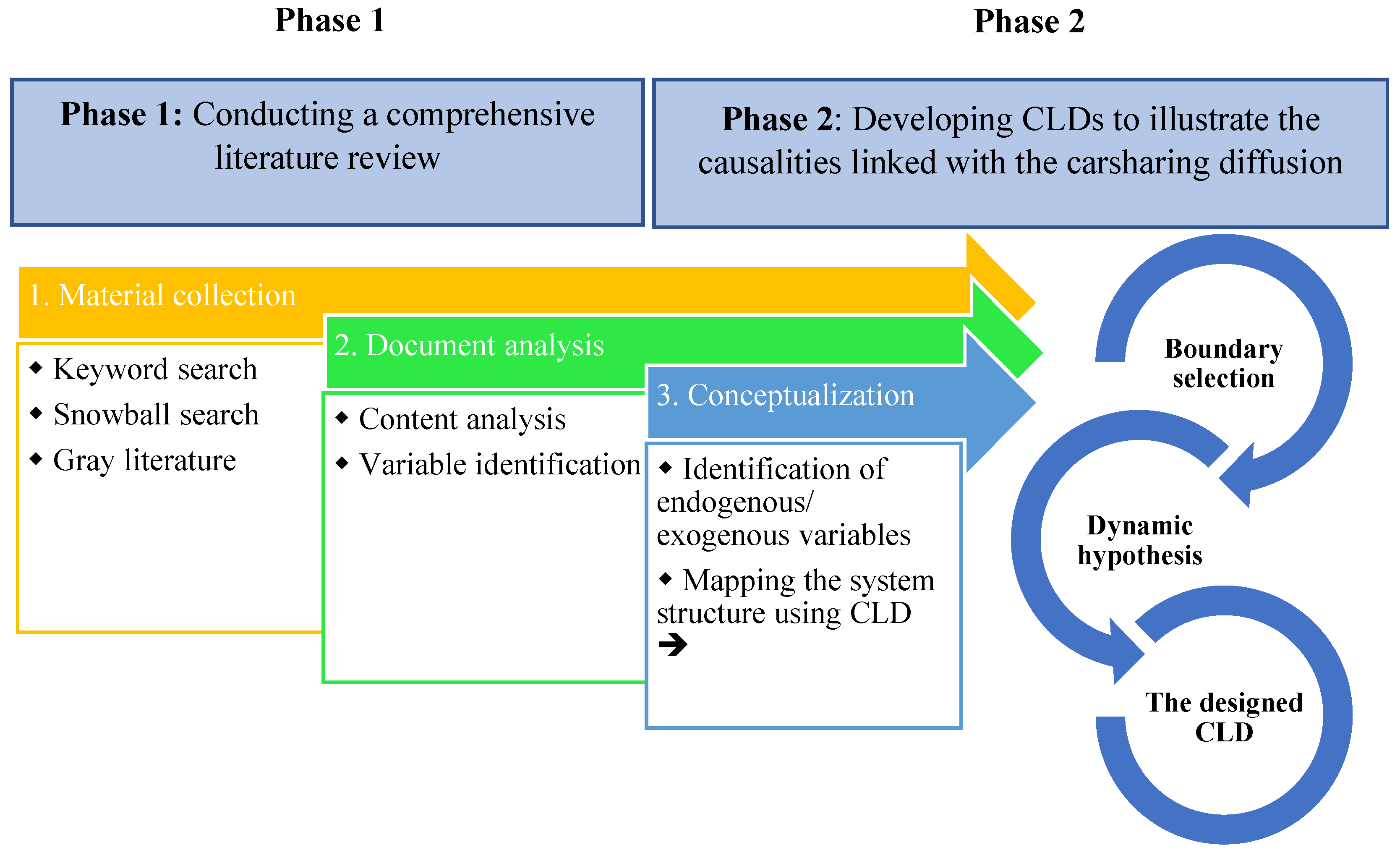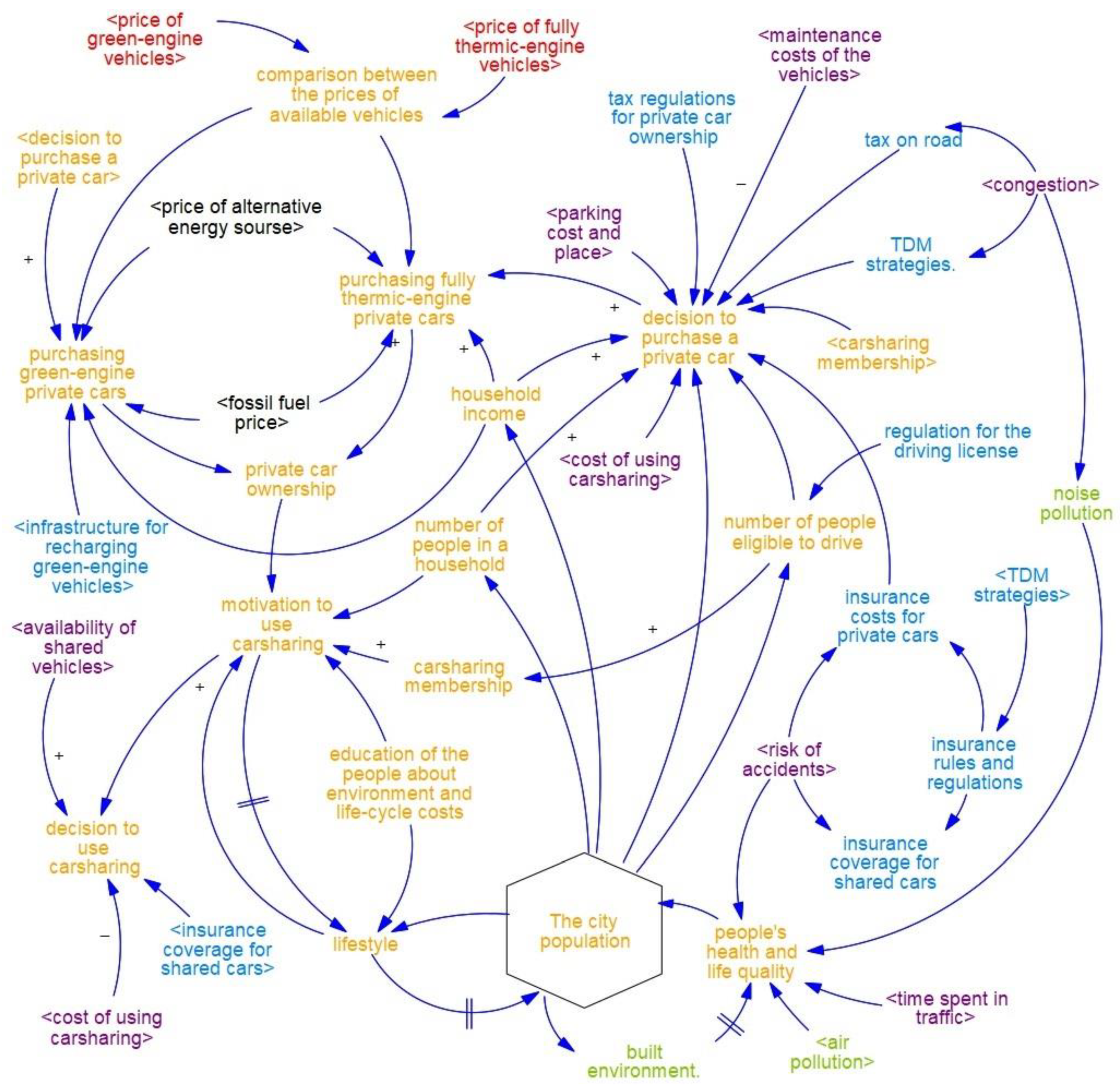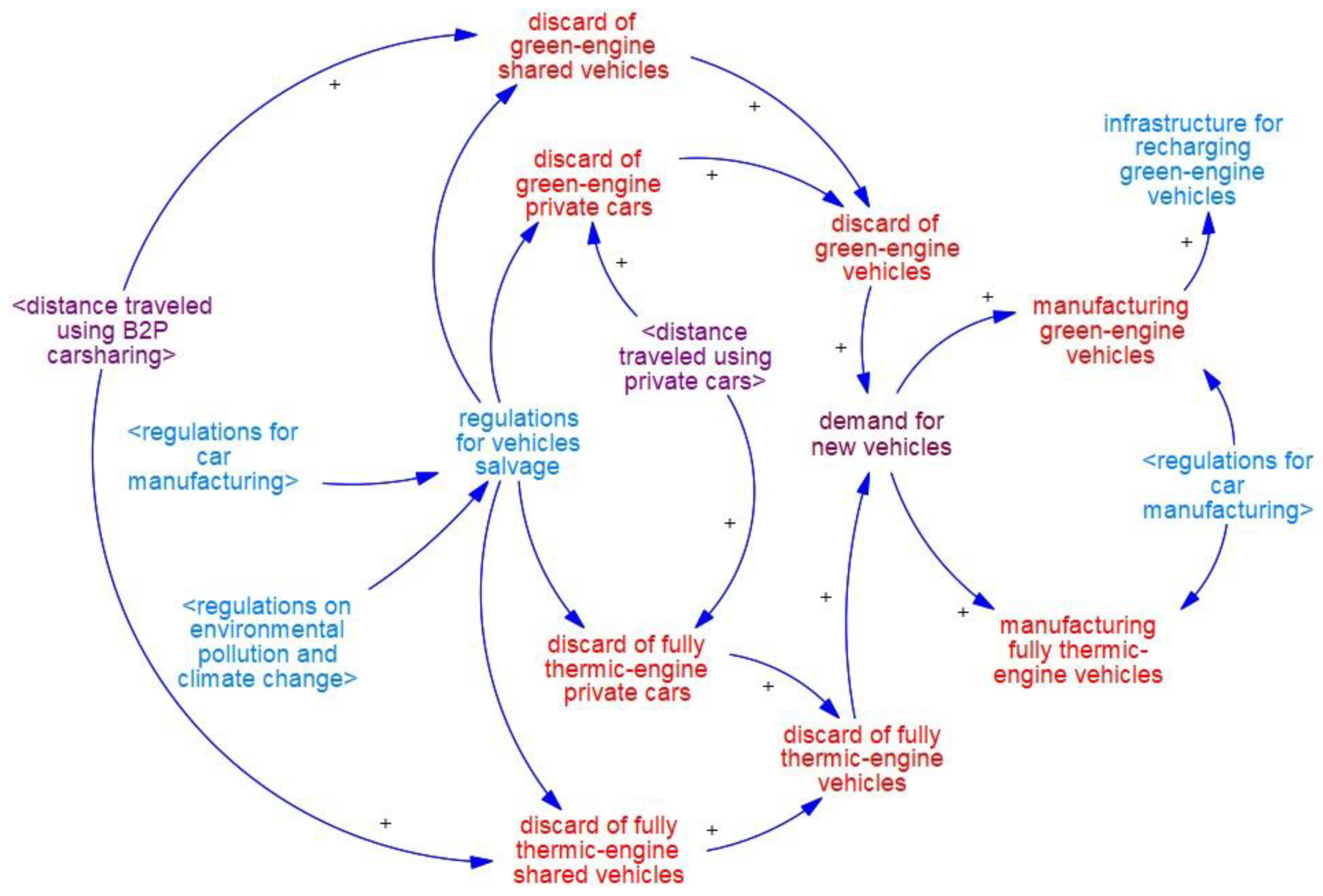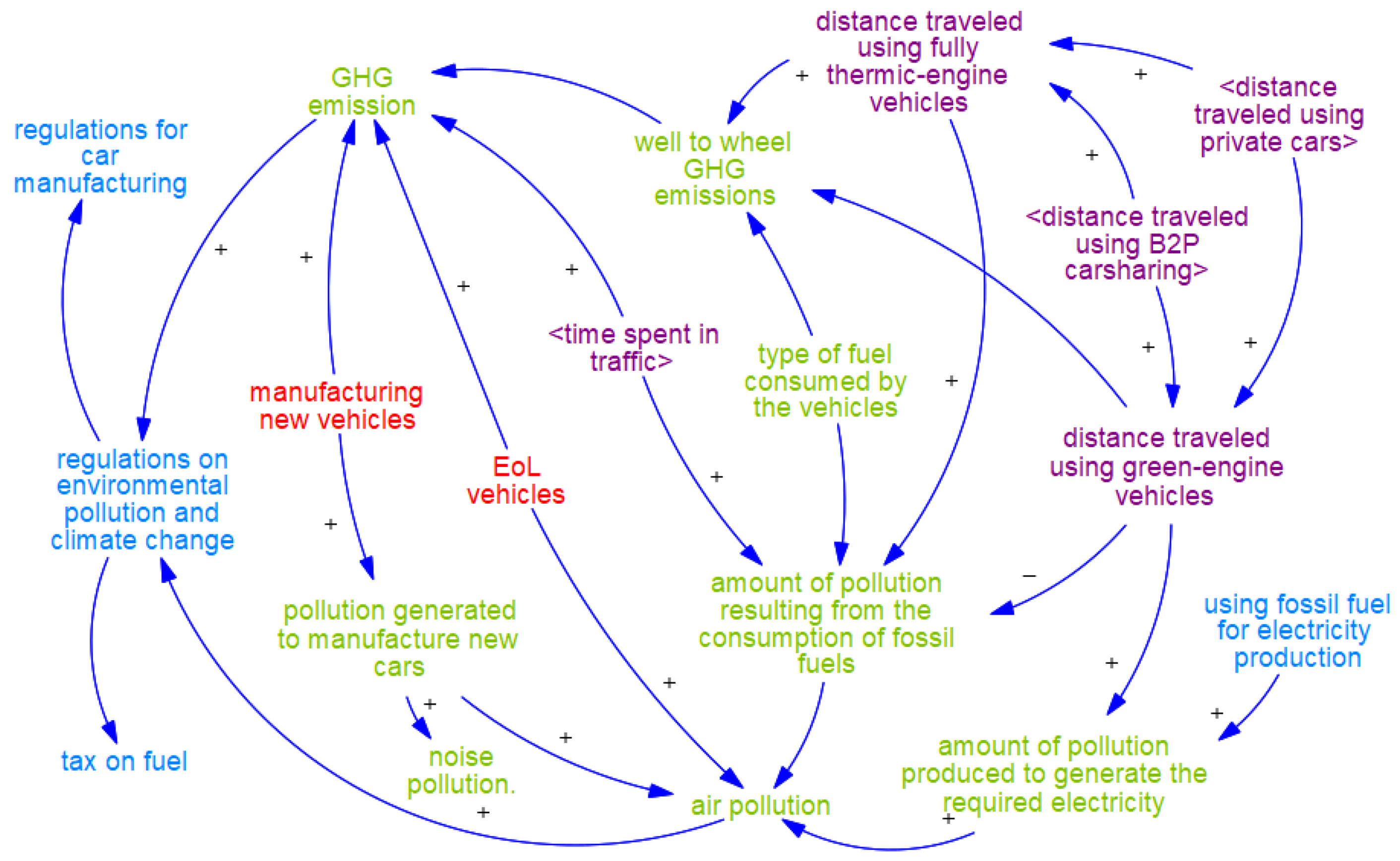Exploring Carsharing Diffusion Challenges through Systems Thinking and Causal Loop Diagrams
Abstract
:1. Introduction
2. Research Background
2.1. Carsharing Business Models
2.2. Carsharing from the Lens of Systems Thinking
3. Methodology
4. Result and Discussion: Cause-and-Effect Relationships in the Diffusion of Carsharing
4.1. Characteristics, Behavior, and Dynamics of the Society Population
4.2. Transportation System and Urban Planning
4.3. The Car Manufacturing Industry
4.4. Environmental Pollution
5. Conclusions and Future Research Direction
Author Contributions
Funding
Institutional Review Board Statement
Data Availability Statement
Conflicts of Interest
References
- UN. World Urbanization Prospects: The 2018 Revision (ST/ESA/SER.A/420); United Nations: New York, NY, USA, 2019. [Google Scholar]
- Wells, P.; Liu, H.; Maurice, S.; Sanvicente, E.; Beccaria, S. STARS Deliverable D3.2—Review of the Impacts on the Automobility Market; STARS-H2020 project. 2018. Available online: https://stars-h2020.eu/ (accessed on 18 December 2022).
- Ranjbari, M.; Morales-Alonso, G.; Carrasco-Gallego, R. Conceptualizing the Sharing Economy through Presenting a Comprehensive Framework. Sustainability 2018, 10, 2336. [Google Scholar] [CrossRef]
- Luna, T.F.; Uriona-Maldonado, M.; Silva, M.E.; Vaz, C.R. The influence of e-carsharing schemes on electric vehicle adoption and carbon emissions: An emerging economy study. Transp. Res. Part D Transp. Environ. 2020, 79, 102226. [Google Scholar] [CrossRef]
- Ferrero, F.; Perboli, G.; Rosano, M.; Vesco, A. Car-sharing services: An annotated review. Sustain. Cities Soc. 2018, 37, 501–518. [Google Scholar] [CrossRef]
- Statista. Car-Sharing—Worldwide 2022. Available online: https://www.statista.com/outlook/mmo/shared-mobility/shared-rides/car-sharing/worldwide#revenue (accessed on 14 September 2022).
- Mounce, R.; Nelson, J.D. On the potential for one-way electric vehicle car-sharing in future mobility systems. Transp. Res. Part A Policy Pract. 2019, 120, 17–30. [Google Scholar] [CrossRef]
- Ampudia-Renuncio, M.; Guirao, B.; Molina-Sanchez, R. The impact of free-floating carsharing on sustainable cities: Analysis of first experiences in Madrid with the university campus. Sustain. Cities Soc. 2018, 43, 462–475. [Google Scholar] [CrossRef]
- Shams Esfandabadi, Z.; Diana, M.; Zanetti, M.C. Carsharing services in sustainable urban transport: An inclusive science map of the field. J. Clean. Prod. 2022, 357, 131981. [Google Scholar] [CrossRef]
- Boons, F.; Bocken, N. Towards a sharing economy—Innovating ecologies of business models. Technol. Forecast. Soc. Change 2018, 137, 40–52. [Google Scholar] [CrossRef]
- Shaheen, S.; Cohen, A.; Farrar, E. Carsharing’s impact and future. In Advances in Transport Policy and Planning, 1st ed.; Elsevier, Inc.: Amsterdam, The Netherlands, 2019; Volume 4, pp. 87–120. [Google Scholar] [CrossRef]
- EC. Directive 2014/94/EU of the European Parliament and of the Council of 22 October 2014 on the Deployment of Alternative Fuels Infrastructure; EC: Brussels, Belgium, 2014. [Google Scholar]
- EC. Directive 2009/33/EC of the European Parliament and of the Council of 23 April 2009 on the Promotion of Clean and Energy-Efficient Road Transport Vehicles; EC: Brussels, Belgium, 2009. [Google Scholar]
- Shams Esfandabadi, Z.; Ravina, M.; Diana, M.; Zanetti, M.C. Conceptualizing environmental effects of carsharing services: A system thinking approach. Sci. Total Environ. 2020, 745, 141169. [Google Scholar] [CrossRef]
- Rodenbach, J.; Mathijs, J.; Chicco, A.; Diana, M.; Nehrke, G. STARS Deliverable D2.1—Car Sharing in Europe A Multidimensional Classification and Inventory; STARS-H2020 project. 2018. Available online: https://stars-h2020.eu (accessed on 18 December 2022).
- Namazu, M.; Dowlatabadi, H. Vehicle ownership reduction: A comparison of one-way and two-way carsharing systems. Transp. Policy 2018, 64, 38–50. [Google Scholar] [CrossRef]
- Martin, E.; Shaheen, S. Impacts of Car2go on Vehicle Ownership, Modal Shift, Vehicle Miles Traveled, and Greenhouse Gas Emissions: An Analysis of Five North American Cities; Work Paper; Transportation Sustainability Research Center, UC Berkeley: Berkeley, CA, USA, 2016. [Google Scholar]
- Shaheen, S.A.; Cohen, A.P. Carsharing and Personal Vehicle Services: Worldwide Market Developments and Emerging Trends. Int. J. Sustain. Transp. 2013, 7, 5–34. [Google Scholar] [CrossRef]
- Del Mar Alonso-Almeida, M. Carsharing: Another gender issue? Drivers of carsharing usage among women and relationship to perceived value. Travel Behav. Soc. 2019, 17, 36–45. [Google Scholar] [CrossRef]
- Shaheen, S.; Cohen, A.; Zohdy, I. Shared Mobility: Current Practices and Guiding Principles; United States. Federal Highway Administration: Washington, DC, USA, 2016. [Google Scholar]
- Shaheen, S.; Cohen, A. Shared ride services in North America: Definitions, impacts, and the future of pooling. Transp. Rev. 2019, 39, 427–442. [Google Scholar] [CrossRef]
- Luo, W.; Wang, Y.; Jiao, P.; Wang, Z.; Zhao, P. What Kind of Travellers Are Using Carsharing in Beijing? A Study Based on Selective Ensemble Learning. Sustainability 2022, 14, 540. [Google Scholar] [CrossRef]
- Lewe, J.-H.; Hivin, L.F.; Mavris, D.N. A multi-paradigm approach to system dynamics modeling of intercity transportation. Transp. Res. Part E Logist. Transp. Rev. 2014, 71, 188–202. [Google Scholar] [CrossRef]
- Hekimoğlu, M.; Barlas, Y. Sensitivity Analysis of System Dynamics Models by Behavior Pattern Measures. In Proceedings of the 28th International Conference of the System Dynamics Society, Seoul, Republic of Korea, 25–29 July 2010. [Google Scholar]
- Gupta, M.; Bandyopadhyay, K.R.; Singh, S.K. Measuring effectiveness of carbon tax on Indian road passenger transport: A system dynamics approach. Energy Econ. 2019, 81, 341–354. [Google Scholar] [CrossRef]
- Vafa-Arani, H.; Jahani, S.; Dashti, H.; Heydari, J.; Moazen, S. A system dynamics modeling for urban air pollution: A case study of Tehran, Iran. Transp. Res. Part D Transp. Environ. 2014, 31, 21–36. [Google Scholar] [CrossRef]
- Liu, P.; Liu, C.; Du, J.; Mu, D. A system dynamics model for emissions projection of hinterland transportation. J. Clean. Prod. 2019, 218, 591–600. [Google Scholar] [CrossRef]
- Ghisolfi, V.; Tavasszy, L.A.; de Almeida Correia, G.H.; de Lorena Diniz Chaves, G.; Ribeiro, G.M. Freight Transport Decarbonization: A Systematic Literature Review of System Dynamics Models. Sustainability 2022, 14, 3625. [Google Scholar] [CrossRef]
- Sayyadi, R.; Awasthi, A. A system dynamics based simulation model to evaluate regulatory policies for sustainable transportation planning. Int. J. Model. Simul. 2017, 37, 25–35. [Google Scholar] [CrossRef]
- He, S.; Li, J. A Study of Urban City Traffic Congestion Governance Effectiveness Based on System Dynamics Simulation. Int. Ref. J. Eng. Sci. 2019, 8, 37–47. [Google Scholar]
- Su, Y.; Liu, X.; Li, X. Research on Traffic Congestion Based on System Dynamics: The Case of Chongqing, China. Complexity 2020, 2020, 6123896. [Google Scholar] [CrossRef]
- Naumov, S.; Keith, D.R.; Fine, C.H. Unintended Consequences of Automated Vehicles and Pooling for Urban Transportation Systems. Prod. Oper. Manag. 2020, 29, 1354–1371. [Google Scholar] [CrossRef]
- Keith, D.R.; Struben, J.J.R.; Naumov, S. The Diffusion of Alternative Fuel Vehicles: A Generalised Model and Future Research Agenda. J. Simul. 2020, 14, 260–277. [Google Scholar] [CrossRef]
- Struben, J.J.R. The Diffusion of Complex Market Technologies: Exploring Multifaceted Dynamics for Alternative Fuel Vehicles. In 2008 Industry Studies Conference Paper. 2008. Available online: https://papers.ssrn.com/sol3/papers.cfm?abstract_id=1135732 (accessed on 18 December 2022).
- Emberger, G.; Pfaffenbichler, P. A quantitative analysis of potential impacts of automated vehicles in Austria using a dynamic integrated land use and transport interaction model. Transp. Policy 2020, 98, 57–67. [Google Scholar] [CrossRef]
- Menon, B.G.; Mahanty, B. Assessing the Effectiveness of Alternative Policies in Conjunction with Energy Efficiency Improvement Policy in India. Environ. Model. Assess. 2015, 20, 609–624. [Google Scholar] [CrossRef]
- Geum, Y.; Lee, S.; Park, Y. Combining technology roadmap and system dynamics simulation to support scenario-planning: A case of car-sharing service. Comput. Ind. Eng. 2014, 71, 37–49. [Google Scholar] [CrossRef]
- Li, S.; Liu, X.; Sun, N.; Yu, Z.; Zhang, F. The construction of a high-active EVCARD online community based on user content adoption and generation model. Multimed. Tools Appl. 2021, 80, 11395–11421. [Google Scholar] [CrossRef]
- May, A.D.; Shepherd, S.; Pfaffenbichler, P.; Emberger, G. The potential impacts of automated cars on urban transport: An exploratory analysis. Transp. Policy 2020, 98, 127–138. [Google Scholar] [CrossRef]
- Boonsiripant, S.; Jittrapirom, P.; Phamornmongkhonchai, M. Understanding the Dynamic of Carsharing Industry in Bangkok, an Application of Participatory Group Modeling; Asian Transportation Research Society: Bangkok, Thailand, 2020. [Google Scholar]
- Jittrapirom, P.; Boonsiripant, S.; Phamornmongkhonchai, M. Aligning stakeholders’ mental models on carsharing system using remote focus group method. Transp. Res. Part D 2022, 101, 103122. [Google Scholar] [CrossRef]
- Kim, S.; Paul, T.; Park, C. Exploring the impact of technological disruptions in the automotive retail: A futures studies and systems thinking approach based on causal layered analysis and causal loop diagram. Technol. Forecast. Soc. Change 2021, 172, 121024. [Google Scholar] [CrossRef]
- Lee, S.Y. Identifying the Motivational Factors for Using Car-Sharing Services in the Netherlands and Korea through Qualitative System Dynamics; Radboud University: Nijmegen, The Netherlands, 2020. [Google Scholar]
- Stasinopoulos, P.; Shiwakoti, N.; Beining, M. Use-stage life cycle greenhouse gas emissions of the transition to an autonomous vehicle fleet: A System Dynamics approach. J. Clean. Prod. 2021, 278, 123447. [Google Scholar] [CrossRef]
- Bass, F.M. A New Product Growth for Model Consumer Durables. Manag. Sci. 1969, 15, 215–227. [Google Scholar] [CrossRef]
- Nieuwenhuijsen, J.; de Almeida Correia, G.H.; Milakis, D.; van Arem, B.; van Daalen, E. Towards a quantitative method to analyze the long-term innovation diffusion of automated vehicles technology using system dynamics. Transp. Res. Part C Emerg. Technol. 2018, 86, 300–327. [Google Scholar] [CrossRef]
- Kaltenhäuser, B.; Werdich, K.; Dandl, F.; Bogenberger, K. Market development of autonomous driving in Germany. Transp. Res. Part A Policy Pract. 2020, 132, 882–910. [Google Scholar] [CrossRef]
- Zhou, B.; Hu, H.; Dai, L. Assessment of the Development of Time-Sharing Electric Vehicles in Shanghai and Subsidy Implications: A System Dynamics Approach. Sustainability 2020, 12, 345. [Google Scholar] [CrossRef]
- Bearden, M. Planning for the Transition to Clean Shared Mobility; Delft University of Technology and Wageningen University and Research: Delft, Netherlands, 2020. [Google Scholar]
- Forrester, J.W. Industrial Dynamics; Massachusetts Institute of Technology: Cambridge, MA, USA, 1961. [Google Scholar]
- Gómez Vilchez, J.J.; Jochem, P. Simulating vehicle fleet composition: A review of system dynamics models. Renew. Sustain. Energy Rev. 2019, 115, 109367. [Google Scholar] [CrossRef]
- Suryani, E.; Chou, S.-Y.; Chen, C.-H. Air passenger demand forecasting and passenger terminal capacity expansion: A system dynamics framework. Expert Syst. Appl. 2010, 37, 2324–2339. [Google Scholar] [CrossRef]
- Sterman, J.D. Business Dynamics: Systems Thinking and Modeling for a Complex World; Jeffrey, J.S., Ed.; Irwin McGraw-Hill: Columbus, OH, USA, 2000. [Google Scholar]
- Chao, Y.; Zishan, M. System Dynamics Model of Shanghai Passenger Transportation Structure Evolution. Procedia—Soc. Behav. Sci. 2013, 96, 1110–1118. [Google Scholar] [CrossRef]
- Groesser, S.N.; Schaffernicht, M. Mental models of dynamic systems: Taking stock and looking ahead. Syst. Dyn. Rev. 2012, 28, 46–68. [Google Scholar] [CrossRef]
- Homer, J.; Oliva, R. Maps and models in system dynamics: A response to Coyle. Syst. Dyn. Rev. 2001, 17, 347–355. [Google Scholar] [CrossRef]
- Wolstenholme, E.F. Qualitative vs quantitative modelling: The evolving balance. J. Oper. Res. Soc. 1999, 50, 422–428. [Google Scholar] [CrossRef]
- Papachristos, G.; Struben, J. System Dynamics Methodology and Research: Opportunities for Transitions Research. In Modelling Transitions: Virtues, Vices, Visions of the Future, 1st ed.; Moallemi, E.A., de Haan, F.J., Eds.; Routledge: New York, NY, USA, 2020; pp. 119–138. [Google Scholar] [CrossRef]
- Cassidy, R.; Borghi, J.; Semwanga, A.R.; Binyaruka, P.; Singh, N.S.; Blanchet, K. How to do (or not to do)… using causal loop diagrams for health system research in low and middle-income settings. Health Policy Plan. 2022, 37, 1328–1336. [Google Scholar] [CrossRef] [PubMed]
- Bouchet, L.; Thoms, M.C.; Parsons, M. Using Causal Loop Diagrams to Conceptualize Groundwater as a Social-Ecological System. Front. Environ. Sci. 2022, 10, 836206. [Google Scholar] [CrossRef]
- Shams Esfandabadi, Z.; Ranjbari, M.; Scagnelli, S.D. The imbalance of food and biofuel markets amid Ukraine-Russia crisis: A systems thinking perspective. Biofuel Res. J. 2022, 9, 1640–1647. [Google Scholar] [CrossRef]
- Mohammad, M.; Desa, W.L.H.M.; Ahmad, N.; Abidin, N.Z. The Impact of Population and Deforestation on Climate Change in Malaysia: A Causal Loop Diagram. Environ. Ecol. Res. 2021, 9, 419–425. [Google Scholar] [CrossRef]
- Jittrapirom, P.; Knoflacher, H.; Mailer, M. Understanding decision makers’ perceptions of Chiang Mai city’s transport problems- an application of Causal Loop Diagram (CLD) methodology. Transp. Res. Procedia 2017, 25, 4438–4453. [Google Scholar] [CrossRef]
- Ranjbari, M.; Morales-Alonso, G.; Shams Esfandabadi, Z.; Carrasco-Gallego, R. Sustainability and the Sharing Economy: Modelling the Interconnections. Dir. Organ. 2019, 68, 33–40. [Google Scholar] [CrossRef]
- Kump, B.; Fikar, C. Challenges of maintaining and diffusing grassroots innovations in alternative food networks: A systems thinking approach. J. Clean. Prod. 2021, 317, 128407. [Google Scholar] [CrossRef]
- Wells, P.; Liu, H.; Beccaria, S. STARS Deliverable D3.3—Review of the Impacts on the Automotive Industry; STARS-H2020 project. 2018. Available online: https://stars-h2020.eu/ (accessed on 18 December 2022).
- Sanvicente, E.; Kielmanowicz, D.; Rodenbach, J.; Chicco, A.; Ramos, E. STARS Deliverable D2.2—Key Technology and Social Innovation Drivers for Car Sharing; STARS-H2020 project. 2018. Available online: https://stars-h2020.eu (accessed on 18 December 2022).
- Ceccato, R.; Diana, M. Substitution and complementarity patterns between traditional transport means and car sharing: A person and trip level analysis. Transportation 2021, 48, 1523–1540. [Google Scholar] [CrossRef]
- Chicco, A.; Diana, M.; Rodenbach, J.; Matthijs, J.; Nehrke, G.; Ziesak, M.; Horvat, M. STARS Deliverable 5.1—Mobility Scenarios of Car Sharing: Gap Analysis and Impacts in the Cities of Tomorrow; 2020. Available online: https://stars-h2020.eu/ (accessed on 18 December 2022).
- Shaheen, S.; Martin, E.; Hoffman-Stapleton, M. Shared mobility and urban form impacts: A case study of peer-to-peer (P2P) carsharing in the US. J. Urban Des. 2021, 26, 141–158. [Google Scholar] [CrossRef]
- Shaheen, S.; Cohen, A.; Randolph, M.; Farrar, E.; Davis, R.; Nichols, A. Shared Mobility Policy Playbook; UC Berkeley: Berkeley, CA, USA, 2019. [Google Scholar] [CrossRef]
- Amirnazmiafshar, E.; Diana, M. A review of the socio-demographic characteristics affecting the demand for different car-sharing operational schemes. Transp. Res. Interdiscip. Perspect. 2022, 14, 100616. [Google Scholar] [CrossRef]
- Turon, K.; Czesh, P.; Toth, J. Safety and security aspects in shared mobility systems. Sci. J. Silesian Univ. Technol. Ser. Transp. 2019, 104, 169–175. [Google Scholar] [CrossRef]
- Ranjbari, M.; Shams Esfandabadi, Z.; Scagnelli, S.D. Sharing Economy Risks: Opportunities or Threats for Insurance Companies? A Case Study on the Iranian Insurance Industry. In The Future of Risk Management, Volume II: Perspectives on Financial and Corporate Strategies; Springer International Publishing: Cham, Switzerland, 2019; Volume II, pp. 343–360. [Google Scholar] [CrossRef]
- Shams Esfandabadi, Z.; Ranjbari, M.; Scagnelli, S.D. Prioritizing Risk-level Factors in Comprehensive Automobile Insurance Management: A Hybrid Multi-criteria Decision-making Model. Glob. Bus. Rev. 2020, 097215092093228. [Google Scholar] [CrossRef]
- Chicco, A.; Diana, M.; Rodenbach, J.; Mathijs, J.; Nehrke, G. STARS Deliverable 2.3—The Growth of Car Sharing in a Business as Usual Scenario; STARS-H2020 project. 2018. Available online: https://stars-h2020.eu/ (accessed on 18 December 2022).
- Liao, F.; Molin, E.; Timmermans, H.; van Wee, B. Carsharing: The impact of system characteristics on its potential to replace private car trips and reduce car ownership. Transportation 2020, 47, 935–970. [Google Scholar] [CrossRef]
- Shaheen, S.A.; Bell, C.; Cohen, A.; Yelchuru, B. Travel Behavior: Shared Mobility and Transportation Equity; Office of Policy & Governmental Affairs: Washington, DC, USA, 2017. [Google Scholar]
- Shaheen, S.A.; Cohen, A.P.; Martin, E. Carsharing Parking Policy. Transp. Res. Rec. J. Transp. Res. Board 2010, 2187, 146–156. [Google Scholar] [CrossRef]
- Shaheen, S. Parking and the city. Transp. Rev. 2019, 39, 826–827. [Google Scholar] [CrossRef]
- Litman, T. Evaluating Carsharing Benefits. Transp. Res. Rec. J. Transp. Res. Board 2000, 1702, 31–35. [Google Scholar] [CrossRef]
- Luo, W.; Qiu, S.; Jiao, P.; Yao, L.; Wang, Y. Does Policy Matter in Carsharing Traveling? Evolution Game Model-Based Carsharing and Private Car Study. J. Adv. Transp. 2022, 2022, 1710746. [Google Scholar] [CrossRef]
- Tashayo, B.; Alimohammadi, A.; Sharif, M. A hybrid fuzzy inference system based on dispersion model for quantitative environmental health impact assessment of urban transportation planning. Sustainability 2017, 9, 134. [Google Scholar] [CrossRef]
- Kopelias, P.; Demiridi, E.; Vogiatzis, K.; Skabardonis, A.; Zafiropoulou, V. Connected & autonomous vehicles—Environmental impacts—A review. Sci. Total Environ. 2020, 712, 135237. [Google Scholar] [CrossRef]
- Struben, J. Essays on Transition Challenges for Alternative Propulsion Vehicles and Transportation Systems; Massachusetts Institute of Technology: Cambridge, MA, USA, 2006. [Google Scholar]
- Turoń, K.; Kubik, A.; Chen, F. What Car for Car-Sharing? Conventional, Electric, Hybrid or Hydrogen Fleet? Analysis of the Vehicle Selection Criteria for Car-Sharing Systems. Energies 2022, 15, 4344. [Google Scholar] [CrossRef]
- Yoon, T.; Cherry, C.R.; Ryerson, M.S.; Bell, J.E. Carsharing demand estimation and fleet simulation with EV adoption. J. Clean. Prod. 2019, 206, 1051–1058. [Google Scholar] [CrossRef]
- Zhang, H.; Sheppard, C.J.R.; Lipman, T.E.; Zeng, T.; Moura, S.J. Charging infrastructure demands of shared-use autonomous electric vehicles in urban areas. Transp. Res. Part D Transp. Environ. 2020, 78, 102210. [Google Scholar] [CrossRef]
- Lopez-Behar, D.; Tran, M.; Froese, T.; Mayaud, J.R.; Herrera, O.E.; Merida, W. Charging infrastructure for electric vehicles in Multi-Unit Residential Buildings: Mapping feedbacks and policy recommendations. Energy Policy 2019, 126, 444–451. [Google Scholar] [CrossRef]
- Schreier, H.; Grimm, C.; Kurz, U.; Schwieger, B.; Keßler, S.; Möser, G. Analysis of the Impacts of Car-Sharing in Bremen, Germany; European Regional Development Fund: Viborg, Denmark, 2018. [Google Scholar]
- Kopp, J.; Gerike, R.; Axhausen, K.W. Do sharing people behave differently? An empirical evaluation of the distinctive mobility patterns of free-floating car-sharing members. Transportation 2015, 42, 449–469. [Google Scholar] [CrossRef]
- Diana, M.; Ceccato, R. A multimodal perspective in the study of car sharing switching intentions. Transp. Lett. 2022, 14, 317–323. [Google Scholar] [CrossRef]
- Litman, T. The Online TDM Encyclopedia: Mobility management information gateway. Transp. Policy 2003, 10, 245–249. [Google Scholar] [CrossRef]
- Ma, Z.; Koutsopoulos, H.N. Optimal design of promotion based demand management strategies in urban rail systems. Transp. Res. Part C Emerg. Technol. 2019, 109, 155–173. [Google Scholar] [CrossRef]
- Cumming, I.; Weal, Z.; Afzali, R.; Rezaei, S.; Idris, A.O. The impacts of office relocation on commuting mode shift behaviour in the context of Transportation Demand Management (TDM). Case Stud. Transp. Policy 2019, 7, 346–356. [Google Scholar] [CrossRef]
- Litman, T. Land Use Impacts on Transport; Victoria Transport Policy Institute: Victoria, BC, Canada, 2020. [Google Scholar]
- EC. Regulation (EU) No. 333/2014 of the European Parliament and of the Council of 11 March 2014 Amending Regulation (EC) No 443/2009 to Define the Modalities for Reaching the 2020 Target to Reduce CO2 Emissions from New Passenger Cars; EC: Brussels, Belgium, 2014. [Google Scholar]
- EC. Regulation (EC) No. 443/2009 of the European Parliament and of the Council of 23 April 2009 Setting Emission Performance Standards for New Passenger Cars as Part of the Community’s Integrated Approach to Reduce CO2 Emissions from Light-Duty Vehicles; EC: Brussels, Belgium, 2009. [Google Scholar] [CrossRef]
- EC. Directive 2005/64/EC of the European Parliament and of the Council of 26 October 2005 on the Type-Approval of Motor Vehicles with Regard to Their Reusability, Recyclability and Recoverability and Amending Council Directive 70/156/EEC; EC: Brussels, Belgium, 2005; ISSN 1725-2555. [Google Scholar]
- EC. Directive 2000/53/EC of the European Parliament and of the Council of 18 September 2000 on End-of Life Vehicles; EC: Brussels, Belgium, 2000; Available online: https://eur-lex.europa.eu/legal-content/EN/TXT/PDF/?uri=CELEX:02000L0053-20130611&qid=1405610569066&from=EN (accessed on 18 December 2022).
- Ameli, M.; Mansour, S.; Ahmadi-Javid, A. A simulation-optimization model for sustainable product design and efficient end-of-life management based on individual producer responsibility. Resour. Conserv. Recycl. 2019, 140, 246–258. [Google Scholar] [CrossRef]
- Shevchenko, T.; Yannou, B.; Saidani, M.; Cluzel, F.; Ranjbari, M.; Esfandabadi, Z.S.; Danko, Y.; Leroy, Y. Product-level circularity metrics based on the “Closing–Slowing Future–Past” quadrant model. Sustain. Prod. Consum. 2022, 34, 395–411. [Google Scholar] [CrossRef]
- IEA. Global EV Outlook 2019: Scaling up the Transition to Electric Mobility; IEA: Paris, France, 2019. [Google Scholar]
- Barisa, A.; Rosa, M. A system dynamics model for CO2 emission mitigation policy design in road transport sector. Energy Procedia 2018, 147, 419–427. [Google Scholar] [CrossRef]
- Vidhi, R.; Shrivastava, P. A Review of Electric Vehicle Lifecycle Emissions and Policy Recommendations to Increase EV Penetration in India. Energies 2018, 11, 483. [Google Scholar] [CrossRef]
- IEA. Perspectives for the Clean Energy Transition—The Critical Role of Buildings; IEA: Paris, France, 2019. [Google Scholar]
- Verboven, H.; Vanherck, L. The sustainability paradox of the sharing economy. uwf UmweltWirtschaftsForum 2016, 24, 303–314. [Google Scholar] [CrossRef]
- Feng, X.; Sun, H.; Wu, J.; Lv, Y. Understanding the factors associated with one-way and round-trip carsharing usage based on a hybrid operation carsharing system: A case study in Beijing. Travel Behav. Soc. 2023, 30, 74–91. [Google Scholar] [CrossRef]
- Wieding, V.; Sprei, F.; Hult, C.; Hult, Å.; Roth, A. Drivers and barriers to business-to-business carsharing for work trips—A case study of Gothenburg, Sweden. Case Stud. Transp. Policy 2022, 10, 2330–2336. [Google Scholar] [CrossRef]
- Zhang, S.; Sun, H.; Wang, X.; Lv, Y.; Wu, J. Optimization of personalized price discounting scheme for one-way station-based carsharing systems. Eur. J. Oper. Res. 2022, 303, 220–238. [Google Scholar] [CrossRef]
- Changaival, B.; Lavangnananda, K.; Danoy, G.; Kliazovich, D.; Guinand, F.; Brust, M.; Musial, J.; Bouvry, P. Optimization of Carsharing Fleet Placement in Round-Trip Carsharing Service. Appl. Sci. 2021, 11, 11393. [Google Scholar] [CrossRef]
- Aguilera-García, Á.; Gomez, J.; Antoniou, C.; Vassallo, J.M. Behavioral factors impacting adoption and frequency of use of carsharing: A tale of two European cities. Transp. Policy 2022, 123, 55–72. [Google Scholar] [CrossRef]
- Vanheusden, W.; van Dalen, J.; Mingardo, G. Governance and business policy impact on carsharing diffusion in European cities. Transp. Res. Part D Transp. Environ. 2022, 108, 103312. [Google Scholar] [CrossRef]





| No. | Title | Author(s) | Study Area | Quantitative/Qualitative Modeling |
|---|---|---|---|---|
| 1 | The influence of e-carsharing schemes on electric vehicle adoption and carbon emissions: An emerging economy study | Luna et al. [4] | Fortaleza, Brazil | Quantitative |
| 2 | Assessing the effectiveness of alternative policies in conjunction with energy efficiency improvement policy in India | Menon and Mahanty [36] | India | Quantitative |
| 3 | Combining technology roadmap and system dynamics simulation to support scenario-planning: A case of car-sharing service | Geum et al. [37] | Korea | Quantitative |
| 4 | A quantitative analysis of potential impacts of automated vehicles in Austria using a dynamic integrated land use and transport interaction model | Emberger and Pfaffenbichler [35] | Austria | Quantitative |
| 5 | The construction of a high-active EVCARD online community based on user content adoption and generation model | Li et al. [38] | EVCARD company | Quantitative |
| 6 | The potential impacts of automated cars on urban transport: An exploratory analysis | May et al. [39] | Leeds, UK | Quantitative |
| 7 | Conceptualizing environmental effects of carsharing services: A system thinking approach | Shams Esfandabadi et al. [14] | General | Qualitative |
Disclaimer/Publisher’s Note: The statements, opinions and data contained in all publications are solely those of the individual author(s) and contributor(s) and not of MDPI and/or the editor(s). MDPI and/or the editor(s) disclaim responsibility for any injury to people or property resulting from any ideas, methods, instructions or products referred to in the content. |
© 2023 by the authors. Licensee MDPI, Basel, Switzerland. This article is an open access article distributed under the terms and conditions of the Creative Commons Attribution (CC BY) license (https://creativecommons.org/licenses/by/4.0/).
Share and Cite
Shams Esfandabadi, Z.; Ranjbari, M. Exploring Carsharing Diffusion Challenges through Systems Thinking and Causal Loop Diagrams. Systems 2023, 11, 93. https://doi.org/10.3390/systems11020093
Shams Esfandabadi Z, Ranjbari M. Exploring Carsharing Diffusion Challenges through Systems Thinking and Causal Loop Diagrams. Systems. 2023; 11(2):93. https://doi.org/10.3390/systems11020093
Chicago/Turabian StyleShams Esfandabadi, Zahra, and Meisam Ranjbari. 2023. "Exploring Carsharing Diffusion Challenges through Systems Thinking and Causal Loop Diagrams" Systems 11, no. 2: 93. https://doi.org/10.3390/systems11020093







